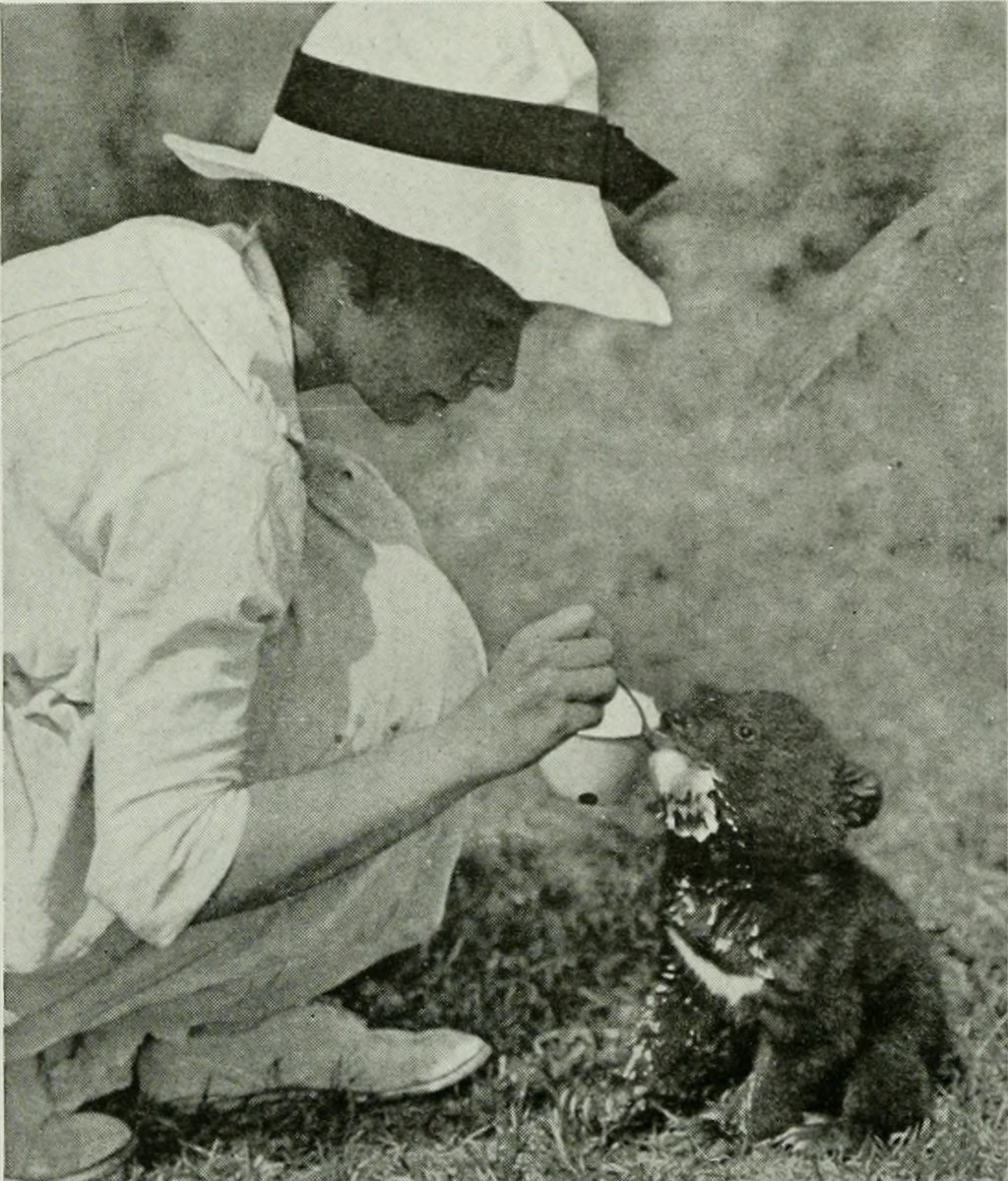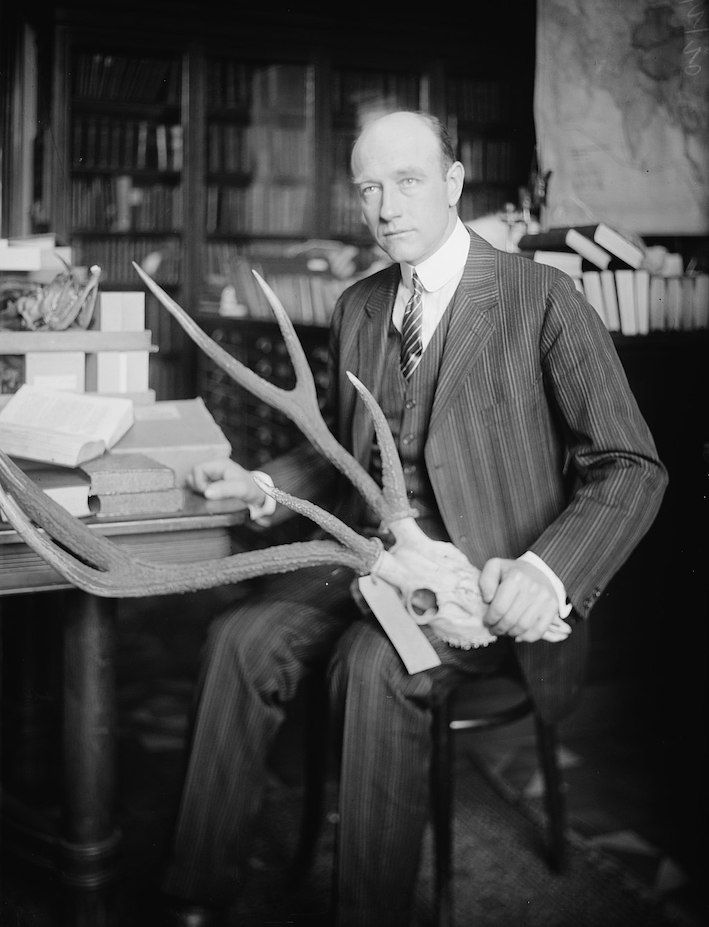

イヴェット・ボラップ・アンドリュースとロイ・チャップマン・アンドリュース
Yvette
Borup Andrews (1891-1959) and Roy Chapman Andrews (1884-1960)


Yvette Borup
Andrews, feeding a Tibetan blue bear cub in 1917/
Explorer Roy Chapman Andrews holding the skull of a deer.
Yvette Borup Andrews (February 28, 1891 – April 12, 1959)
| Yvette Borup
Andrews
(February 28, 1891 – April 12, 1959) was an American photographer
associated with the American Museum of Natural History. With the
museum's director, Roy Chapman Andrews, she traveled to Central Asia
twice during 1916-18 for the museum's First and Second Asiatic
Zoological Expeditions. |
イ
ヴェット・ボラップ・アンドリュース(1891年2月28日 -
1959年4月12日)は、アメリカ自然史博物館に所属していたアメリカの写真家。1916年から18年にかけて、館長のロイ・チャップマン・アンド
リュースとともに、第1次、第2次アジア動物学探検隊として中央アジアに渡った。 |
| Yvette
Huen Borup was born in Paris to American parents, Henry Dana Borup
(1854–1916) and Mary Watson Brandreth Borup (1854–1897). Her father was
an American military attaché in Paris and Berlin before World War I.
Her maternal grandfather, George A. Brandreth, and her
great-grandfather, Congressman Aaron Ward, were both New York
politicians. Her great-great-grandfather, Elkanah Watson, was a notable
New York businessman. Her older brother, George Brandreth Borup
(1885–1912), was assistant to Robert Peary on the North Pole
Expedition, and wrote a book about his experiences in the Arctic.
Yvette Borup was educated in France, Germany, Italy, and New York.[1]
One of her school friends at the Kaiserin Auguste Institute was
Princess Victoria Louise of Prussia.[2][3] |
イ
ヴェット・ヒューン・ボラップは、アメリカ人の両親、ヘンリー・ダナ・ボラップ(1854-1916)とメアリー・ワトソン・ブランドレス・ボラップ
(1854-1897)の間にパリで生まれた。父は第一次世界大戦前にパリとベルリンに駐在したアメリカ軍の駐在官であった。母方の祖父ジョージ・A・ブ
ランドレスと曾祖父の下院議員アーロン・ウォードはともにニューヨークの政治家であった。曽祖父のエルカナ・ワトソンはニューヨークの実業家として知られ
る。兄のジョージ・ブランドレス・ボラップ(1885-1912)は、北極探検隊でロバート・ピアリーの助手を務め、北極での体験について本を書いてい
る。カイゼリン・アウグスト学院の友人にはプロシアのヴィクトリア・ルイーズ王女がいた[2][3]。 |
| Yvette
Borup Andrews was an ethnographic photographer and filmmaker[4] for the
American Museum of Natural History. She was the photographer assigned
to the museum's First Asiatic Zoological Expedition (1916–1917), to
China, Tibet, and Burma, and the Second Asiatic Zoological Expedition
(1918), to Mongolia and North China, both expeditions led by her
husband. She developed her still images and films in a portable "rubber
darkroom" in the field. In the 1920s she was again in the field with
Andrews, as photographer on the museum's Central Asiatic Expeditions.
On that trip, she photographed the last Maidari Festival in
Ulaanbaatar, creating a valuable historical document of the custom.[1] Her photographs were published in Camps and Trails in China (1918), a book she co-authored with her husband.[5] More photographs by Andrews appeared in Across Mongolian Plains (1921).[6] Soon after their 1931 divorce, Roy Chapman Andrews told an audience that "Physically and intellectually, women may be the equals of men for the work of exploration, but temperamentally they are not. They do not stand up under the little daily annoyances that loom large to them in the somewhat trying work involved on an expedition. The trivialities which men can ignore completely disturb them and prevent them from settling down to hard and conscientious work." The Society of Woman Geographers objected to his observations.[7] In 1940, she was active with the Committee to Defend America by Aiding the Allies, volunteering as a "Minute Woman" at a phone bank to build support for the United States' entry into World War II.[8] |
イ
ヴェット・ボラップ・アンドリュースは、アメリカ自然史博物館の民族誌写真家・映像作家[4]である。夫が率いる第1次アジア動物学遠征隊(1916-
17年)の中国、チベット、ビルマ、第2次アジア動物学遠征隊(1918年)のモンゴル、華北の写真家であった。彼女は、静止画やフィルムを現地で携帯用
の「ゴム暗室」で現像していました。1920年代、彼女は再びアンドリュースとともに、博物館の中央アジア探検隊の写真家として現地に赴いた。この旅で彼
女はウランバートルで行われた最後のマイダリ祭を撮影し、この風習の貴重な歴史的資料を作成した[1]。 彼女の写真は夫との共著である『Camps and Trails in China』(1918年)に掲載され、アンドリュースの写真は『Across Mongolian Plains』(1921年)にも掲載されている[6]。 1931年の離婚後すぐ、ロイ・チャップマン・アンドリュースは「肉体的にも知的にも、女性は探検という仕事では男性と同等かもしれないが、気質的には違 う」と観客に語っている[7] 。探検に関わるやや困難な仕事の中で、彼女らに大きく立ちはだかる日々の小さな悩みに耐えられないのだ。男性なら無視できるような些細なことでも、彼女た ちは完全に邪魔をし、一生懸命、良心的な仕事をすることを妨げてしまうのです」。女性地理学者協会は彼の観察に異議を唱えた[7]。 1940年、彼女は連合国を助けることによってアメリカを守るための委員会で活動し、アメリカの第二次世界大戦への参戦への支持を集めるための電話銀行で 「ミニット・ウーマン」としてボランティアをしていた[8]。 |
| Yvette
Borup married naturalist Roy Chapman Andrews (1884–1960) in 1914; he
was an acquaintance of her late brother.[9] She had two sons. The
father of George Borup Andrews (1917–2007) was Roy Chapman Andrews but,
although Yvette was married to Roy Chapman Andrews at the time of the
birth of her second son, Roy Kevin Andrews (1924–1989), the first man
to visit her to see the newborn son was not Roy Chapman Andrews, but
Harold St Clair (Chips) Smallwood. On the eve of Kevin’s marriage
nearly 30 years later, Yvette announced to Kevin that Smallwood, and
not Roy Chapman Andrews was his father. Yvette and Roy Chapman Andrews
were divorced in 1931.[10][11] She died in a 1959 traffic accident,
near Bahabón de Esgueva, in the province of Burgos, Spain, aged 68
years.[12] |
イヴェット・
ボラップは1914年に博物学者のロイ・チャップマン・アンドリュース(1884-1960)と結婚したが、彼は彼女の亡兄の知人であった[9]。ジョー
ジ・ボーラップ・アンドリュース(1917-2007)の父親はロイ・チャップマン・アンドリュースだったが、次男のロイ・ケヴィン・アンドリュース
(1924-1989)が生まれたとき、イヴェットはロイ・チャップマン・アンドリュースと結婚していたが、生まれたばかりの息子に会いに彼女を最初に訪
れたのはロイ・チャップマン・アンドルーズではなくハロルド・スト・クレア(チップス)スモールウッドであった。約30年後、ケビンの結婚前夜、イヴェッ
トはケビンに、ロイ・チャップマン・アンドリュースではなく、スモールウッドが自分の父親であることを告げた。イヴェットとロイ・チャップマン・アンド
リュースは1931年に離婚した[10][11]。
1959年にスペインのブルゴス県バハボン・デ・エスゲバ付近で交通事故により68歳で死去した[12]。 |
| https://en.wikipedia.org/wiki/Yvette_Borup_Andrews |
https://www.deepl.com/ja/translator |
Roy Chapman Andrews (January 26, 1884 – March 11, 1960)
| Roy Chapman
Andrews
(January 26, 1884 – March 11, 1960) was an American explorer,
adventurer and naturalist who became the director of the American
Museum of Natural History.[1] He led a series of expeditions through
the politically disturbed China of the early 20th century into the Gobi
Desert and Mongolia. The expeditions made important discoveries and
brought the first-known fossil dinosaur eggs to the museum. Chapman's
popular writing about his adventures made him famous. |
ロイ・チャップマン・アンドリュース(1884年1月26
日 -
1960年3月11日)は、アメリカの探検家、冒険家、博物学者で、アメリカ自然史博物館の館長[1]。彼は20世紀初頭の政情不安な中国から、ゴビ砂漠
とモンゴルへの一連の探検を主導した。この探検は重要な発見をもたらし、初めて知られる恐竜の卵の化石を博物館に持ち込んだ。チャップマンは、その冒険を
綴った人気作によって一躍有名になる。 |
| Andrews
was born on January 26, 1884, in Beloit, Wisconsin. As a child, he
explored forests, fields, and waters nearby, developing marksmanship
skills. He taught himself taxidermy and used funds from this hobby to
pay tuition to Beloit College. After graduating, Andrews applied for
work at the American Museum of Natural History in New York City. He so
much wanted to work there that after being told that there were no
openings at his level, Andrews accepted a job as a janitor in the
taxidermy department and began collecting specimens for the museum.
During the next few years, he worked and studied simultaneously,
earning a Master of Arts degree in mammalogy from Columbia University.
Andrews joined The Explorers Club in New York during 1908, four years
after its founding. |
アンドリュースは1884年1月26日、ウィスコンシン州
ベロイトで生まれた。幼少の頃、近くの森や野原、水辺を探検し、射撃の腕を磨いた。独学で剥製作りを学び、この趣味で得た資金をベロイト大学の学費に充て
た。卒業後、アンドリュースはニューヨークのアメリカ自然史博物館に就職を希望した。卒業後、ニューヨークのアメリカ自然史博物館に就職を希望したアンド
リュースは、「あなたのレベルでは募集していない」と言われた後、剥製部門の清掃員の仕事を受け、博物館の標本収集を開始した。その後数年間、彼は仕事と
勉強を同時にこなし、コロンビア大学で哺乳類学の修士号を取得した。1908年、ニューヨークの探検家クラブが設立されて4年後、アンドリュースはそのク
ラブに入会した。 |
| From
1909 to 1910, Andrews sailed on the USS Albatross to the East Indies,
collecting snakes and lizards and observing marine mammals. In 1913, he
sailed aboard the schooner Adventuress with owner John Borden to the
Arctic. They were hoping to obtain a bowhead whale specimen for the
American Museum of Natural History. On this expedition, he filmed some
of the best footage of seals ever seen, though did not succeed in
acquiring a whale specimen. He married Yvette Borup in 1914. From 1916 to 1917, Andrews and his wife led the Asiatic Zoological Expedition of the museum through much of western and southern Yunnan, as well as other provinces of China. The book Camps and Trails in China records their experiences. In 1920, Andrews began planning for expeditions to Mongolia and drove a fleet of Dodge cars westward from Peking. In 1922, the party discovered a fossil of Indricotherium (then named "Baluchitherium"), a gigantic hornless rhinoceros, which was sent back to the museum, arriving on December 19. The fossil species Andrewsarchus was named after him. Andrews, along with Henry Fairfield Osborn, was a proponent of the Out of Asia theory of humanity's origins and led several expeditions to Asia from 1922 to 1928 known as the "Central Asiatic Expeditions" to search for the earliest human remains in Asia. The expeditions did not find human remains. However, Andrews and his team made many other finds, including dinosaur bones and fossil mammals and the first nests full of dinosaur eggs ever discovered. Andrews' account of these expeditions can be found in his book The New Conquest of Central Asia.[2] |
1909年から1910年にかけて、アンドリュースは
USSアルバトロス号で東インドを訪れ、ヘビやトカゲを採集し、海洋哺乳類を観察しました。1913年には、オーナーのジョン・ボーデンとともにスクー
ナー船「アドヴェンチャーズ号」で北極圏に向かいました。アメリカ自然史博物館に寄贈するホッキョククジラの標本が目的だった。この探検では、アザラシの
最高の映像を撮影したが、クジラの標本は手に入れることができなかった。 1914年、イヴェット・ボラップ(Yvette Borup)と結婚。1916年から1917年にかけて、アンドリュース夫妻は博物館のアジア動物学遠征隊を率いて、雲南省の西部と南部の大部分と中国の 他の省を探検した。その時の様子を記録したのが『Camps and Trails in China』である。 1920年、アンドリュースはモンゴルへの遠征を計画し、北京からダッジ車一式を西へ走らせた。1922年、一行は巨大な角のないサイ、インドリコテリウ ム(当時はバルキテリウムと命名)の化石を発見し、博物館に送り返し、12月19日に到着した。この化石をもとに、アンドリューサーカス (Andrewsarchus)という種が名づけられた。 アンドリュースは、ヘンリー・フェアフィールド・オズボーンとともに「アジア外来説」を唱え、1922年から1928年にかけて「中央アジア探検隊」と呼 ばれる数回のアジアへの探検を主導し、アジアで最古の人類の遺跡を探した。しかし、この探検では人骨は見つからなかった。しかし、アンドリュースたちは、 恐竜の骨や哺乳類の化石、史上初めて発見された恐竜の卵が詰まった巣など、多くの発見をしました。これらの探検に関するアンドリュースの記録は、彼の著書 『The New Conquest of Central Asia』に掲載されている[2]。 |
| In his
preface to Andrews's 1926 book, On the Trail of the Ancient Man, Henry
Fairfield Osborn predicted that the birthplace of modern humans would
be found in Asia and stated that he had predicted this decades earlier,
even before the Asiatic expeditions.[3] On July 13, 1923, the party was the first in the world to discover dinosaur eggs. Initially thought to be eggs of a ceratopsian, Protoceratops, they were determined in 1995 actually to belong to the theropod Oviraptor.[4] During that same expedition, Walter W. Granger discovered a skull from the Cretaceous period. In 1925, the museum sent a letter back informing the party that the skull was that of a mammal, and therefore even more rare and valuable; more were uncovered. Expeditions in the area stopped during 1926 and 1927. In 1928, the expedition's finds were seized by Chinese authorities but were eventually returned. The 1929 expedition was cancelled. In 1930, Andrews made one final trip and discovered some mastodon fossils. A cinematographer, James B. Shackelford, made filmed records of many of Andrews' expeditions. (Sixty years after Andrews' initial expedition, the American Museum of Natural History sent a new expedition to Mongolia on the invitation of its government to continue exploration.) Later that year, Andrews returned to the United States and divorced his wife, with whom he had two sons. He married his second wife, Wilhelmina Christmas, in 1935. In 1927, the Boy Scouts of America made Andrews an Honorary Scout, a new category of Scout created that same year. This distinction was given to "American citizens whose achievements in outdoor activity, exploration and worthwhile adventure are of such an exceptional character as to capture the imagination of boys...".[5] Andrews was President of The Explorers Club from 1931 to 1934. In 1934, he became the director of the Natural History museum. In his 1935 book The Business of Exploring, he wrote "I was born to be an explorer...There was never any decision to make. I couldn't do anything else and be happy." In 1942, Andrews retired to North Colebrook, Connecticut. He and Wilhelmina lived on a country estate of 160 acres, "PondOWoods". He wrote most of his autobiographical books of life and adventures here. Around 1958, Andrews moved to Carmel Valley, California. He died on March 11, 1960, of heart failure at Peninsula Community Hospital in Carmel, California.[1] He is buried in Oakwood Cemetery in his hometown of Beloit. |
ヘンリー・フェアフィールド・オズボーンは、アンドリュースが1926
年に出版した『古代人の軌跡』の序文で、現代人の発祥地がアジアで発見されると予測し、アジア探検隊より何十年も前からこのことを予測していたと述べてい
る[3]。 1923年7月13日、一行は世界で初めて恐竜の卵を発見した。当初はセラトプス類のプロトケラトプスの卵と考えられていたが、1995年に獣脚類のオ ヴィラプトルの卵であることが判明した[4] 同日の探検で、ウォルター・W・グレンジャーが白亜紀の頭骨を発見している。1925年、博物館はその頭蓋骨が哺乳類のものであり、より希少価値が高いこ とを知らせる手紙を返送し、さらに多くの頭蓋骨が発見された。1926年から1927年にかけては、この地域の探検は中止された。1928年には中国当局 に押収されたが、結局返還された。1929年の探検は中止された。1930年、アンドリュースは最後の探検を行い、マストドンの化石をいくつか発見した。 1930年、アンドリュースは最後の探検に出かけ、マストドンの化石を発見した。アンドリュースの最初の探検から60年後、アメリカ自然史博物館はモンゴ ル政府の招きで新たな探検隊を派遣し、探検を続けました(アンドリュースの最初の探検から60年後。) その年の暮れ、アンドリュースはアメリカに戻り、2人の息子をもうけた妻と離婚した。1935年、2番目の妻ウィルヘルミン・クリスマスと結婚した。 1927年、ボーイスカウトはアンドリュースを名誉スカウトの称号を与えた。この栄誉は「野外活動、探検、価値ある冒険において、少年たちの想像力をかき 立てるような例外的な性格を持つ業績を残したアメリカ市民」に与えられた...[5]。 アンドリュースは1931年から1934年まで探検家クラブの会長であった。1934年、彼は自然史博物館の館長になった。1935年の著書『The Business of Exploring』では、「私は探検家になるために生まれてきた...決めるべきことは何もなかった。他のことをして幸せになることはできなかった" と書いています。1942年、アンドリュースはコネチカット州のノース・コールブルックに引退した。彼とウィルヘルミナは、160エーカーの広大な敷地に ある「ポンドウッズ」に住んだ。彼はここで、人生や冒険を綴った自伝的な本のほとんどを書きました。1958年頃、アンドリュースはカリフォルニアのカー メル・バレーに移り住む。1960年3月11日、心不全のためカリフォルニア州カーメルのペニンシュラ・コミュニティ病院で死去[1]。 故郷ベロイトのオークウッド墓地に埋葬されている。 |
| Douglas
Preston of the American Museum of Natural History wrote: "Andrews is
allegedly the person that the movie character of Indiana Jones was
patterned after. However, neither George Lucas nor the other creators
of the films have confirmed this. Other candidates have been suggested,
including Colonel Percy Fawcett. The 120-page transcript of the story
conferences for the movie does not mention Andrews."[6] An analysis by the Smithsonian Channel concludes that the linkage was indirect, with Andrews (and other explorers) serving as the model for heroes in adventure films of the 1940s and 1950s, who in turn inspired Lucas and his fellow writers.[7][8] |
アメリカ自然史博物館のダグラス・プレストンは、「アンド
リュースは、映画『インディ・ジョーンズ』のキャラクターのモデルになった人物だと言われている。しかし、ジョージ・ルーカスも他の映画制作者も、これを
確認していない。他の候補としては、パーシー・フォーセット大佐などが挙げられている。映画のためのストーリー会議の120ページに及ぶ記録には、アンド
リュースについて触れられていない」[6]。 スミソニアン・チャンネルの分析では、アンドリュース(および他の探検家)が1940年代と1950年代の冒険映画のヒーローのモデルとして活躍し、それ がルーカスと彼の仲間の作家にインスピレーションを与えたと、関連は間接的であると結論づけている[7][8]。 |
| https://en.wikipedia.org/wiki/Roy_Chapman_Andrews. |
https://www.deepl.com/ja/translator |
+++
Links
リンク
文献
その他の情報
Copyleft, CC, Mitzub'ixi Quq Chi'j, 1996-2099
☆
 ☆
☆